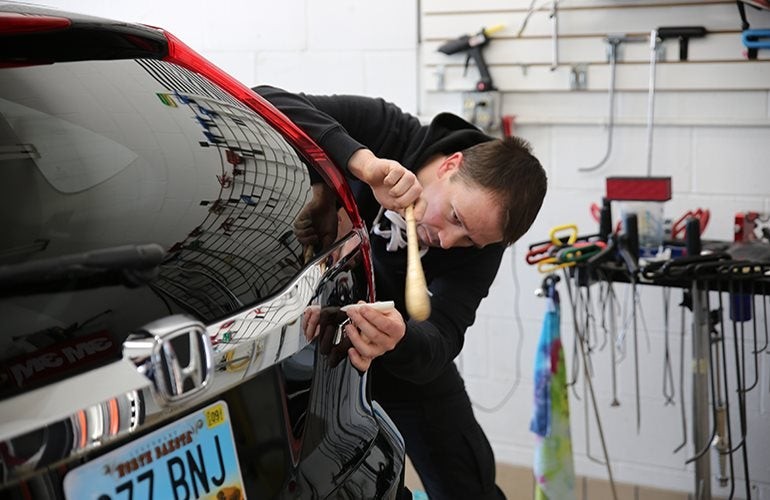Driving around can expose your vehicle to various hazards, from stray rocks and minor collisions to hail storms, all of which can leave unsightly dents. While dents might seem like mere cosmetic issues, ignoring them can lead to more serious problems like rust and further structural damage. Understanding how auto body shops approach dent repair can help you make informed decisions when your car needs attention. This guide from Car Repair Online will walk you through the dent repair process at a body shop, the techniques used, and why addressing dents promptly is crucial.
The Importance of Timely Car Dent Repair
 Paintless Dent Repair (PDR) Technique: A skilled auto technician uses specialized tools to carefully remove a car dent without damaging the original paint.
Paintless Dent Repair (PDR) Technique: A skilled auto technician uses specialized tools to carefully remove a car dent without damaging the original paint.
Car dents are more than just blemishes on your vehicle’s appearance. Delaying repairs can result in significant and costly damage over time. Here’s why immediate dent repair is essential:
- Rust Prevention: Even minor impacts can create cracks in your car’s paint, allowing moisture to penetrate and reach the bare metal underneath. This exposure leads to oxidation and the formation of rust. Rust is not only unsightly but also weakens the metal structure and spreads if left untreated, making repairs increasingly expensive.
- Avoiding Extensive Paint Damage: Dent repair often involves addressing paint damage around the dented area. Cracked or scratched paint, if neglected, can worsen due to weather exposure and everyday wear. This can lead to paint peeling and flaking, exposing more metal and significantly escalating repair costs.
- Ensuring Vehicle Safety: In some cases, dents, especially those resulting from collisions, can indicate underlying structural damage. For example, impacts to quarter panels can bend the underlying metal, affecting the vehicle’s structural integrity and stability. This compromised structure can make your car less safe to drive and increase the risk of accidents.
Car Dent Repair: A Step-by-Step Look at the Body Shop Process
Auto body shops follow a systematic approach to car dent repair, though the exact process can vary depending on the shop and the severity of the damage. Generally, the repair process involves these key steps:
1. Initial Assessment and Cleaning: The first step is a thorough inspection of the dented area. Technicians begin by cleaning the area to get a clear view of the damage’s extent. This cleaning removes dirt and debris that could obscure the dent and helps in accurate assessment.
2. Repair or Replace Decision: A crucial decision is whether to repair the dented panel or replace it entirely. Technicians evaluate the dent’s severity, particularly looking for kinks or sharp bends. If the metal is sharply creased at an angle exceeding 90 degrees, panel replacement might be more practical and cost-effective. They also consider the labor hours required for repair versus replacement, opting for the more economical solution.
3. Dent Repair Techniques: If repair is deemed feasible, body shops utilize various techniques and tools to restore the panel’s shape. Common methods include:
* **Pliers and Hammers with Dollies:** For accessible dents, technicians use specialized pliers to gently pull or push the dent out. Hammers and dollies (metal blocks held against the opposite side of the panel) are used to carefully reshape the metal without causing further damage.
* **Stud Welding:** For more complex dents, especially in areas with limited access, stud welding might be employed. This technique involves welding pins (studs) to the dented area and using a pulling tool to carefully pull the dent out.
* **Suction Cups:** Large suction cups can be effective for pulling out broad, shallow dents, particularly on larger panels like roofs or hoods.
* **Paintless Dent Repair (PDR):** For dents without paint damage, PDR is often the preferred method. PDR involves accessing the dent's backside, often through windows, headlight or taillight openings, or small access points in door jambs. In some cases, interior panels might need temporary removal. Once access is gained, specialized metal rods and picks are used to gently massage and manipulate the metal back to its original contour from behind, preserving the factory paint finish.4. Surface Smoothing and Refinishing: After the dent is pulled out and reshaped, minor imperfections might remain. To achieve a smooth, flawless surface, technicians may apply body filler and hardener. This filler is then carefully sanded down to match the surrounding panel contours. Finally, the repaired area is painted to perfectly match the vehicle’s color, ensuring a seamless finish.
Understanding Dent Removal Costs
The cost of car dent repair varies based on the dent’s size, depth, and complexity, as well as whether painting is required.
- Minor Dings: Small, shallow dings can be relatively inexpensive to fix, potentially costing as little as $50 to $125.
- Medium to Large Dents: More substantial dents, such as those from collisions or impacts with objects, typically range from $200 to $300 or more to repair.
- Paintless Dent Repair (PDR) Costs: For dents suitable for PDR, the cost is often calculated per inch, ranging from $50 to $120 per inch, especially for dents not requiring painting.
- Dents Requiring Painting: If painting is necessary after dent repair, expect to add an extra $200 to $500 to the total cost.
- Panel Replacement Costs: In cases of severe damage where panel replacement is more economical than repair, costs can vary widely. Bumper replacements can range from $300 to $700, while replacing a door or other larger panel can exceed $1,000.
Choosing a Certified Auto Body Shop for Dent Repair
When it comes to car dent repair, selecting the right body shop is as important as understanding the repair process itself. While cheaper options might be tempting, they can compromise on quality, potentially leading to unsatisfactory results. Substandard body shops might use inferior materials, paints, and less skilled technicians, resulting in issues like color mismatching, uneven paint application, or inconsistent textures that can detract from your vehicle’s appearance and value.
Opting for a reputable, certified auto dealership’s body shop offers significant advantages. Certified dealerships adhere to stringent manufacturer standards and invest in advanced repair equipment and technologies. Their service centers employ factory-trained technicians who possess specialized expertise in working with your specific vehicle make and model. This expertise ensures that they use the correct repair techniques for your type of dent and achieve a perfect paint color match. Furthermore, if panel replacement is necessary, dealerships provide genuine OEM (Original Equipment Manufacturer) parts, guaranteeing quality and fit.
For reliable, high-quality dent repair services, consider choosing a certified dealership like Rydell Chevrolet Buick GMC, Rydell Cadillac, or Rydell Honda Nissan in Grand Forks. Contact us today to schedule a service appointment and restore your vehicle to its best condition.

